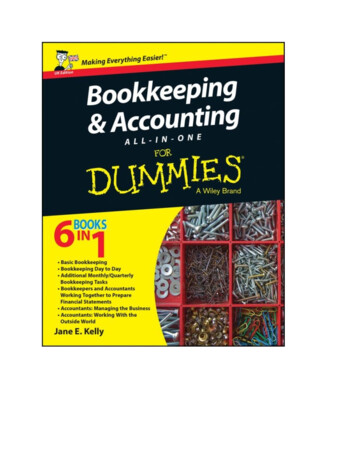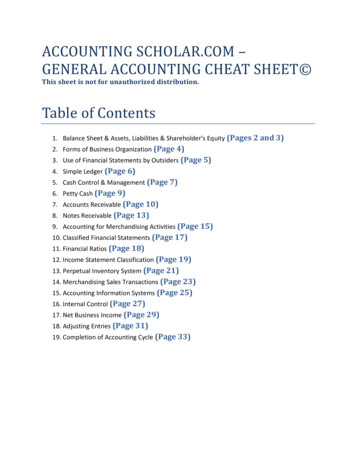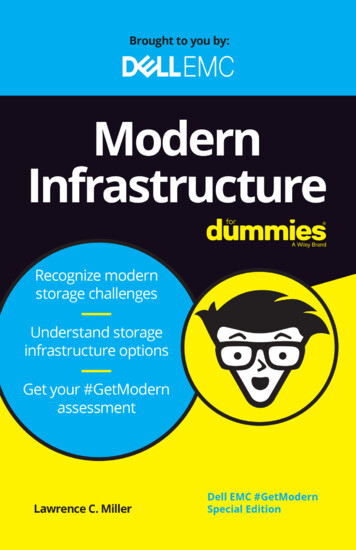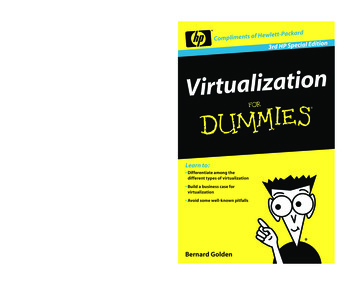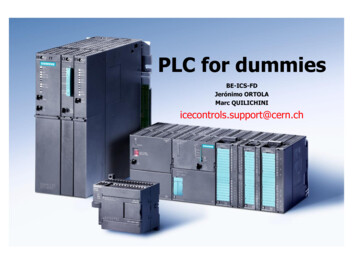
Transcription
AccountingFORDUMmIES‰4THEDITIONBy John A. Tracy, CPA
Accounting For Dummies , 4th EditionPublished byWiley Publishing, Inc.111 River St.Hoboken, NJ 07030-5774www.wiley.comCopyright 2008 by Wiley Publishing, Inc., Indianapolis, IndianaPublished by Wiley Publishing, Inc., Indianapolis, IndianaPublished simultaneously in CanadaNo part of this publication may be reproduced, stored in a retrieval system, or transmitted in any formor by any means, electronic, mechanical, photocopying, recording, scanning, or otherwise, except aspermitted under Sections 107 or 108 of the 1976 United States Copyright Act, without either the priorwritten permission of the Publisher, or authorization through payment of the appropriate per-copy fee tothe Copyright Clearance Center, 222 Rosewood Drive, Danvers, MA 01923, 978-750-8400, fax 978-646-8600.Requests to the Publisher for permission should be addressed to the Legal Department, Wiley Publishing,Inc., 10475 Crosspoint Blvd., Indianapolis, IN 46256, 317-572-3447, fax 317-572-4355, or online at http://www.wiley.com/go/permissions.Trademarks: Wiley, the Wiley Publishing logo, For Dummies, the Dummies Man logo, A Reference for theRest of Us!, The Dummies Way, Dummies Daily, The Fun and Easy Way, Dummies.com and related tradedress are trademarks or registered trademarks of John Wiley & Sons, Inc. and/or its affiliates in the UnitedStates and other countries, and may not be used without written permission. All other trademarks are theproperty of their respective owners. Wiley Publishing, Inc., is not associated with any product or vendormentioned in this book.LIMIT OF LIABILITY/DISCLAIMER OF WARRANTY: THE PUBLISHER AND THE AUTHOR MAKE NO REPRESENTATIONS OR WARRANTIES WITH RESPECT TO THE ACCURACY OR COMPLETENESS OF THECONTENTS OF THIS WORK AND SPECIFICALLY DISCLAIM ALL WARRANTIES, INCLUDING WITHOUTLIMITATION WARRANTIES OF FITNESS FOR A PARTICULAR PURPOSE. NO WARRANTY MAY BE CREATED OR EXTENDED BY SALES OR PROMOTIONAL MATERIALS. THE ADVICE AND STRATEGIES CONTAINED HEREIN MAY NOT BE SUITABLE FOR EVERY SITUATION. THIS WORK IS SOLD WITH THEUNDERSTANDING THAT THE PUBLISHER IS NOT ENGAGED IN RENDERING LEGAL, ACCOUNTING, OROTHER PROFESSIONAL SERVICES. IF PROFESSIONAL ASSISTANCE IS REQUIRED, THE SERVICES OF ACOMPETENT PROFESSIONAL PERSON SHOULD BE SOUGHT. NEITHER THE PUBLISHER NOR THEAUTHOR SHALL BE LIABLE FOR DAMAGES ARISING HEREFROM. THE FACT THAT AN ORGANIZATIONOR WEBSITE IS REFERRED TO IN THIS WORK AS A CITATION AND/OR A POTENTIAL SOURCE OF FURTHER INFORMATION DOES NOT MEAN THAT THE AUTHOR OR THE PUBLISHER ENDORSES THE INFORMATION THE ORGANIZATION OR WEBSITE MAY PROVIDE OR RECOMMENDATIONS IT MAY MAKE.FURTHER, READERS SHOULD BE AWARE THAT INTERNET WEBSITES LISTED IN THIS WORK MAY HAVECHANGED OR DISAPPEARED BETWEEN WHEN THIS WORK WAS WRITTEN AND WHEN IT IS READ.For general information on our other products and services, please contact our Customer CareDepartment within the U.S. at 800-762-2974, outside the U.S. at 317-572-3993, or fax 317-572-4002.For technical support, please visit www.wiley.com/techsupport.Wiley also publishes its books in a variety of electronic formats. Some content that appears in print maynot be available in electronic books.Library of Congress Control Number: 2008926448ISBN: 978-0-470-24600-9Manufactured in the United States of America10 9 8 7 6 5 4 3 2 1
About the AuthorJohn A. Tracy (Boulder, Colorado) is Professor of Accounting, Emeritus, atthe University of Colorado in Boulder. Before his 35-year tenure at Boulder,he was on the business faculty for four years at the University of Californiain Berkeley. Early in his career he was a staff accountant with Ernst & Young.John is the author of several books on accounting and finance, including TheFast Forward MBA in Finance, How To Read a Financial Report, and SmallBusiness Financial Management Kit For Dummies with his son Tage Tracy.John received his BSC degree from Creighton University. He earned his MBAand PhD degrees at the University of Wisconsin in Madison. He is a CPA (inactive) in Colorado.
DedicationFor our grandchildren — Alexander, Ryan, Mitchel, Paige, Katrina, Claire,Eric, MacKenzie, Madison, Tanner, Karsen, and Brody.Author’s AcknowledgmentsI’m deeply grateful to everyone at Wiley Publishing who helped produce thisbook. Their professionalism, courtesy, and good humor were much appreciated. I supplied some words, and the editors and production staff at Wileymolded them into the finished product.Out of the blue, I got a call in 1996 from Kathy Welton, then Vice Presidentand Publisher for the Consumer Publishing Group of the For Dummies books.Kathy asked if I’d be interested in doing this book. It didn’t take me very longto say yes. Thank you again, Kathy!I can’t say enough nice things about Pam Mourouzis, who was project editoron the first edition of the book. The book is immensely better for her insightsand advice. The two copyeditors on the book — Diane Giangrossi and JoeJansen — did a wonderful job. Mary Metcalfe provided valuable suggestionson the manuscript. Thanks to Holly McGuire and Jill Alexander who encouraged me to revise the book. The second edition benefited from the editing byNorm Crampton and Ben Nussbaum.I thank Stacy Kennedy, acquisitions editor, for asking me to do this and theprevious revision. Joan Friedman was the project editor on this and theprevious edition. Evidently, Wiley assigned me the best editor they have.Joan kept a steady hand on the tiller as we sailed through the choppy watersof the revisions. Joan was a delight to work with, and it goes without sayingthat she made the book much better. Thank you most sincerely Joan, and Ihope to work with you again on the next revision.One reason I like to write books goes back to an accounting class in myundergraduate days at Creighton University in Omaha. I took a course taughtby the Dean of the Business School, Dr. Floyd Walsh. I turned in a term paper,and he said that it was very well written. I have never forgotten that compliment. I think my old Prof would be proud of this book and might even give mean “A” on the assignment.
Publisher’s AcknowledgmentsWe’re proud of this book; please send us your comments through our Dummies online registrationform located at www.dummies.com/register/.Some of the people who helped bring this book to market include the following:Acquisitions, Editorial, andMedia DevelopmentProject Editor: Joan Friedman(Previous Editions: Norm Crampton,Pam Mourouzis)Acquisitions Editor: Stacy KennedyComposition ServicesProject Coordinator: Katie KeyLayout and Graphics: Brooke Graczyk,Melissa K. Jester, Laura Pence,Christine WilliamsTechnical Editor: Michael Newman, PhDProofreaders: Laura Albert, John Greenough,Nancy L. ReinhardtEditorial Manager: Jennifer EhrlichIndexer: Infodex Indexing Services, Inc.Editorial Supervisor: Carmen KrikorianEditorial Assistants: Erin Calligan Mooney,Joe Niesen, David LuttonCartoons: Rich Tennant(www.the5thwave.com)Publishing and Editorial for Consumer DummiesDiane Graves Steele, Vice President and Publisher, Consumer DummiesJoyce Pepple, Acquisitions Director, Consumer DummiesKristin A. Cocks, Product Development Director, Consumer DummiesMichael Spring, Vice President and Publisher, TravelKelly Regan, Editorial Director, TravelPublishing for Technology DummiesAndy Cummings, Vice President and Publisher, Dummies Technology/General UserComposition ServicesGerry Fahey, Vice President of Production ServicesDebbie Stailey, Director of Composition Services
Contents at a GlanceIntroduction .1Part I: Opening the Books on Accounting.11Chapter 1: Accounting: The Language of Business, Investing, Finance, and Taxes.13Chapter 2: Financial Statements and Accounting Standards.31Chapter 3: Bookkeeping and Accounting Systems.53Part II: Figuring Out Financial Statements .75Chapter 4: Reporting Revenue, Expenses, and the Bottom Line.77Chapter 5: Reporting Assets, Liabilities, and Owners’ Equity.97Chapter 6: Reporting Cash Flows .119Chapter 7: Choosing Accounting Methods: Different Strokes for Different Folks.137Part III: Accounting in Managing a Business .159Chapter 8: Deciding the Legal Structure for a Business .161Chapter 9: Analyzing and Managing Profit .183Chapter 10: Financial Planning, Budgeting, and Control.205Chapter 11: Cost Concepts and Conundrums .223Part IV: Preparing and Using Financial Reports .245Chapter 12: Getting a Financial Report Ready for Release .247Chapter 13: How Lenders and Investors Read a Financial Report.271Chapter 14: How Business Managers Use a Financial Report .293Chapter 15: Audits and Accounting Fraud .311Part V: The Part of Tens .321Chapter 16: Ten Accounting Tips for Managers .323Chapter 17: Ten Tips for Reading a Financial Report .333Glossary: Slashing Through the AccountingJargon Jungle .343Index .357
Table of ContentsIntroduction.1About This Book.1Conventions Used in This Book .2What You’re Not To Read .4Foolish Assumptions .5How This Book Is Organized.6Part I: Opening the Books on Accounting .6Part II: Figuring Out Financial Statements.7Part III: Accounting in Managing a Business .7Part IV: Preparing and Using Financial Reports .8Part V: The Part of Tens.8Glossary.8Icons Used in This Book.9Where to Go from Here.9Part I: Opening the Books on Accounting .11Chapter 1: Accounting: The Language of Business,Investing, Finance, and Taxes . . . . . . . . . . . . . . . . . . . . . . . . . . . . . . . . . .13Accounting Is Not Just for Accountants.14Affecting both insiders and outsiders .14Overcoming the stereotypes of accountants.15Relating accounting to your personal financial life .16Looking for Accounting in All the Right Places .17Taking a Peek into the Back Office.18Focusing on Transactions .21Taking the Pulse of a Business: Financial Statements .23Meeting the balance sheet and the accounting equation .24Reporting profit and loss, and cash flows.25Respecting the importance of this trio.26Considering Accounting Careers .27Certified public accountant (CPA) .27The controller: The chief accountant in an organization.28A springboard to other careers .29
xiiAccounting For Dummies, 4th EditionChapter 2: Financial Statements and Accounting Standards . . . . . . .31Introducing the Information Content of Financial Statements.32Setting up the business example.32The income statement .33The balance sheet .35The statement of cash flows .37How Profit and Cash Flow from Profit Differ .40Gleaning Key Information from Financial Statements .41How’s profit performance?.41Is there enough cash? .42Can you trust the financial statement numbers?Are the books cooked?.43Why no cash distribution from profit? .44Keeping in Step with Accounting and Financial Reporting Standards .45Recognizing U.S. standards .45Getting to know the U.S. standard setters .47Going worldwide.48Noting a divide between public and private companies.49Recognizing how income tax methods influenceaccounting methods.50Following the rules and bending the rules.51Chapter 3: Bookkeeping and Accounting Systems . . . . . . . . . . . . . . . .53Bookkeeping and Beyond.54Pedaling Through the Bookkeeping Cycle .54Managing the Bookkeeping and Accounting System.59Categorize your financial information: The chart of accounts.59Standardize source document forms and procedures .61Hire competent, trained personnel.62Enforce strong — I mean strong! — internal controls .63Complete the process with end-of-period procedures.65Leave good audit trails .66Look out for unusual events and developments .66Design truly useful reports for managers .67Double-Entry Accounting for Single-Entry Folks.68Juggling the Books to Conceal Embezzlement and Fraud .70Using Accounting Software .72Part II: Figuring Out Financial Statements .75Chapter 4: Reporting Revenue, Expenses, and the Bottom Line . . . . .77Presenting a Typical Income Statement .78Taking care of some housekeeping details .79Your job: Asking questions!.81Finding Profit .84
Table of ContentsGetting Particular about Assets and Liabilities.86Making sales on credit Accounts receivable asset.86Selling products Inventory asset .87Prepaying operating costs Prepaid expense asset.87Fixed assets Depreciation expense .88Unpaid expenses Accounts payable, accrued expensespayable, and income tax payable .89Summing Up the Financial Effects of Profit.91Reporting Extraordinary Gains and Losses.92Closing Comments .95Chapter 5: Reporting Assets, Liabilities, and Owners’ Equity . . . . . . .97Understanding That Transactions Drive the Balance Sheet.98Presenting a Balance Sheet.100Kicking balance sheets out into the real world .102Internal balance sheets.103External balance sheets .103Judging solvency .103Current (short-term) assets .104Current (short-term) liabilities .104Current ratio.105Preparing multiyear statements .105Coupling the Income Statement and Balance Sheet .106Sizing up assets and liabilities .108Sales revenue and accounts receivable.109Cost of goods sold expense and inventory.109Fixed assets and depreciation expense.110SG&A expenses and their three balance sheet accounts.111Intangible assets and amortization expense .112Debt and interest expense .113Income tax expense and income tax payable .114Net income and cash dividends (if any).114Financing a Business.115Costs and Other Balance Sheet Values.117Chapter 6: Reporting Cash Flows . . . . . . . . . . . . . . . . . . . . . . . . . . . . . .119Seeing the Big Picture of Cash Flows.119Meeting the Statement of Cash Flows .122Dissecting the Difference Between Cash Flow and Net Income .125Accounts receivable change .126Inventory change.127Prepaid expenses change.127The depreciation factor .128Changes in operating liabilities .129Putting the cash flow pieces together .130xiii
xivAccounting For Dummies, 4th EditionSailing Through the Rest of the Statement of Cash Flows .131Investing activities .131Financing activities .132Trying to Pin Down “Free Cash Flow”.134Being an Active Reader .135Chapter 7: Choosing Accounting Methods:Different Strokes for Different Folks . . . . . . . . . . . . . . . . . . . . . . . . . . .137Reading Statements with a Touch of Skepticism .138Recognizing a business’s bias.138Contrasting aggressive and conservative numbers.139Figuring Out Why Financial Statements Differ .141Cash balance .142Accounts receivable balance .143Inventory and cost of goods sold expense .144Cost of fixed assets, accumulated depreciation,and depreciation expense .145Accrued expenses payable liability balance.146Wrapping things up .147Calculating Cost of Goods Sold and Cost of Inventory .148The FIFO (first-in, first-out) method.149The LIFO (last-in, first-out) method .150The average cost method.152Recording Inventory Losses under the Lower of Costor Market (LCM) Rule .153Appreciating Depreciation Methods.154Scanning the Expense Horizon .156Part III: Accounting in Managing a Business.159Chapter 8: Deciding the Legal Structure for a Business . . . . . . . . . .161Studying the Sources of Business Capital.162Deciding on debt .162Tapping two sources of owners’ equity.163Recognizing the Legal Roots of Business Entities .165Incorporating a Business .165Issuing stock shares .166Offering different classes of stock shares .167Determining the market value of stock shares.169Keeping alert for dilution of share value.170Recognizing conflicts between stockholders and managers.172Considering Partnerships and Limited Liability Companies.173Going It Alone: Sole Proprietorships .176
Table of ContentsChoosing the Right Legal Structure for Income Tax .178C corporations .179S corporations .180Partnerships and LLCs .181Chapter 9: Analyzing and Managing Profit . . . . . . . . . . . . . . . . . . . . . .183Helping Managers Do Their Jobs .184Following the organizational structure.184Centering on profit centers .185Presenting a P&L Template.186Reporting operating expenses on the objectof expenditure basis .187Reporting operating expenses on their cost behavior basis.187Separating variable and fixed expenses .189Variable expenses .189Fixed expenses.190Stopping at operating earnings .191Focusing on margin — the catalyst of profit.192Answering Two Critical Profit Questions .192How did you make profit? .192How did you increase profit? .194Looking More Closely at the Profit Center P&L Report .195Sales volume .195Sales revenue .195Cost of goods sold.196Variable operating expenses.196Fixed operating expenses.197Using the P&L Template for Decision-Making Analysis.198Tucking Away Some Valuable Lessons .199Recognize the leverage effect caused by fixedoperating expenses .199Don’t underestimate the impact of smallchanges in sales price .200Know your options for improving profit .201Closing with a Boozy Example.202Chapter 10: Financial Planning, Budgeting, and Control . . . . . . . . . .205Exploring the Reasons for Budgeting .206Modeling reasons for budgeting.207Planning reasons for budgeting.208Management control reasons for budgeting.209Additional benefits of budgeting, and a note of caution .210xv
xviAccounting For Dummies, 4th EditionRealizing That Not Everyone Budgets.212Avoiding budgeting .212Relying on internal accounting reports.213Making reports useful for management control .213Making reports useful for decision-making .213Making reports clear and straightforward .214Watching Budgeting in Action .214Developing your profit strategy and budgeted profit report.216Budgeting cash flow for the coming year.218Considering Capital Expenditures and Other Cash Needs .220Chapter 11: Cost Concepts and Conundrums . . . . . . . . . . . . . . . . . . . .223Looking down the Road to the Destination of Costs .224Are Costs Really That Important? .225Becoming More Familiar with Costs .226Direct versus indirect costs .228Fixed versus variable costs.229Relevant versus irrelevant costs .229Actual, budgeted, and standard costs .230Product versus period costs.231Assembling the Product Cost of Manufacturers .232Minding manufacturing costs .232Classifying costs properly .234Calculating product cost .236Examining fixed manufacturing costs and production capacity.237The burden rate .237Idle capacity .238The effects of increasing inventory.238Puffing Profit by Excessive Production .240Shifting fixed manufacturing costs to the future.240Cranking up production output.241Being careful when production output is outof kilter with sales volume.243Part IV: Preparing and Using Financial Reports.245Chapter 12: Getting a Financial Report Ready for Release . . . . . . . .247Recognizing Management’s Role.
By John A.Tracy,CPA Accounting FOR DUMmIES‰ 4TH EDITION 01_246009 ffirs.qxp 4/16/08 11:49 PM Page iiiFile Size: 1MB
